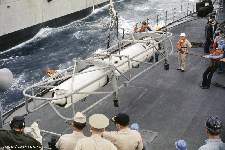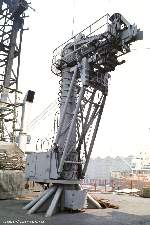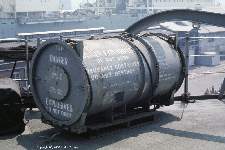Talos Ordnance Transfer
Missiles, boosters and warheads were taken on board or shipped off board at a missile transfer station on the O2 level deck over the missile house Area 3 Missile Storage Magazine. Missiles and boosters were transferred in wheeled carts called grasshoppers. Different grasshoppers were used to transport missiles and boosters. The procedures for handling boosters were essentially the same as for handling missiles.

Grasshoppers were open frame carts with support straps that ran under the missile. A tubular framework surrounded the missile to provide protection when the grasshopper was being moved. The wheels could be locked so the cart couldn't roll. During underway replenishment the supply ship used highline transfer to move the grasshopper (with or without a missile) to the receiving ship. When it arrived over the missile transfer station the grasshopper was lowered to the deck. There a crew from GM Division would gather around the cart to hold it in position when the highline cable was released. The grasshopper brakes were released and the cart was manhandled into position over a Strikedown Hatch in the deck over Area 3 and the wheels were locked.
The operator in Area 3 opened the hydraulically powered Strikedown Hatch which swung down below the deck. Then the Strikedown Elevator was raised to mate with the missile in the grasshopper. This usually required a bit of fussing with the grasshopper position before the adjustable cradles in the elevator mated with the missile. The missile was locked into position on the elevator and then the grasshopper support straps were removed. The missile was lowered into position between the transfer rails in Area 3 and the Strikedown Hatch was closed. Transfer of a missile from the Talos ship to the supply ship was just the opposite procedure.

The Talos system originally used a traditional highline ordnance transfer system to transfer missiles at sea. In 1963 a mechanical transfer crane called FAST (Fast Automated Shuttle Transfer) was installed on top of the missile house to catch the arriving missile. FAST was mounted on a kingpost positioned in the center of the missile transfer station. The hydraulically powered FAST machinery was attached to a frame that could rotate around the kingpost to face port or starboard. A pantograph arm on the frame could be raised to a vertical position beside the kingpost and lowered horizontal to a position at the Strikedown Hatch. In all positions of the arm a mating bracket at the end was oriented so a transfer bar attached to the missile was held horizontal. The transfer highline from the receiving ship was attached at the top of the kingpost. As it arrived on the highline the transfer bar on the missile mated with a bracket on the end of the vertical pantograph arm. When it was was securely attached the arm was lowered to the horizontal position where the missile was automatically positioned over the waiting elevator in the Strikedown Hatch. A missile transfer could be completed every 90 seconds.
At least that is how it was supposed to work. FAST was a plumber's nightmare with hydraulic hoses running everywhere. The entire rig was exposed to the weather and required constant maintenance to control rust, corrosion and hydraulic fluid leaks. It was unreliable and inevitably failed during transfers, prolonging the time the ships had to steam in close formation while the pile of junk was repaired.
During the 1960s and 70s the Navy was introducing a huge amount of new technology into the fleet. Nuclear submarines, ballistic missile submarines, high speed jet aircraft, new avionics and aircraft missile weapons systems, surface to air and surface to surface missiles, advanced radars, sonars, new communications systems, computers, the Navy Tactical Data System, satellite communications, weather satellite systems, and nuclear weapons all entered the fleet at the same time. None of these new systems had existing support, and there were no experienced senior enlisted personnel or officers who knew anything about the new equipment. Nothing in the WWII navy served to prepare for this huge technology influx.
The Navy suddenly needed very intelligent young men in large numbers, and this was not the type of personnel who normally joined the Navy. There just weren't enough bright people to keep all of the new equipment running. Anyone entering naval service who appeared to have significant intelligence was sent to training schools for these new sophisticated systems. Many just couldn't pass the training and were sent back to the fleet to chip paint. The lengthy training actually contributed to the problem by delaying the time from entry into the Navy until the time the men went to the fleet. The Navy sent the brightest recruits to the places with highest demand - nuclear submarines and aircraft detachments. Other parts of the fleet suffered reduced availability because there weren't enough trained personnel to keep the equipment running. This was the problem with the FAST automated missile transfer system on the Oklahoma City. It didn't work because we did not have trained technicians to keep it working.
Eventually the frame, arm and hydraulics were removed, and just the kingpost remained. The missile transfer system that replaced FAST was called STREAM (Standard Tensioned Replenishment Alongside Method). This was just an ordinary highline transfer using a cable attached to the top of the FAST kingpost and shuttles riding on the cable carrying grasshoppers with missiles. So we scrapped the high tech wonder and went back to WWII ammunition transfer methods where sailors manhandled the 3000-4000 pound missiles and boosters.

Warheads were shipped in Talos warhead containers. Conventional and nuclear warheads were shipped in the same containers, and for security purposes no external markings indicated the type of warhead inside. Only the serial number stenciled on the can identified the contents.
The warhead containers were moved to warhead strikedown hatches in the O2 level deck over the port and starboard Area 1 test cells. A warhead davit was mounted on the deck beside each hatch. The container consisted of two cylindrical pieces fastened together by bolts and mating flanges. The container was positioned on end and the bolts were removed so the two ends could be separated. The warhead was fastened to one end. The warhead was lifted with the warhead davit and lowered into the Special Weapons Office on the second deck where it was attached to a waiting warhead receiving stand. From there it was transferred to the warhead magazine.
In port at Naval Weapons Depots missiles and boosters in grasshoppers or warheads in shipping containers were brought along side on trucks or barges. A crane (dockside or floating) lifted the ordnance to the missile transfer area.
Nukes and Grunts
The missile house and warhead storage magazine were nuclear weapons spaces. This means the spaces and equipment in them were designed to accommodate nuclear weapons when and if such weapons were on board.
Access to nuclear weapons spaces was tightly controlled. Only personnel authorized by the ship's Captain were allowed into these spaces. A top secret restricted information security clearance was required for entry into nuclear weapons spaces. The Two Man Rule was observed any time personnel had access to nuclear weapons spaces. No one was allowed access to nuclear weapons alone. Only two or more people were allowed access to a space, and they were responsible for ensuring that even authorized personnel were not left alone with a nuclear weapon. This rule was not strictly enforced for occasionally one person might be working in the lower test cell while another would be operating equipment in the equipment room above. Though they might be out of sight of each other for a few minutes, they basically knew where the other person was and what he was doing.
The ship carried a Marine detachment that guarded the nuclear weapons spaces. All hatches and doors into the missile house and warhead magazine were fitted with alarms that sounded in the Marine Detachment Office if the door or hatch was opened. When the alarm sounded armed Marines swarmed to the open access like hornets from a disturbed nest. If a hatch or door needed to be opened an authorization notice was presented to the Marine Sergeant of the Watch. He dispatched armed guards to the door or hatch, and after they were in place he disarmed that particular alarm. This procedure also was followed for ordnance transfers through the strikedown hatches. Anyone passing into the nuclear weapons space must be carrying a missile house ID badge issued by the ship's Captain. The guards were authorized to shoot to kill to stop anyone trying to enter nuclear weapons spaces without proper clearance.
Normally only one hatch was open between the missile house and the rest of the ship. This hatch was in the main deck in Area 1, with a ladder leading down to a guard room on the 2nd deck just aft of the mess decks. An armed Marine guard was stationed at this post around the clock. To gain access to the missile house personnel entered the guard room and showed their service ID card. The guard checked the name against the authorized entry list, verified that the picture on the ID was the person requesting entry, located the person's missile house badge, and then verified that the photo on the badge was also of the person requesting entry. If everything matched the missile house badge was handed over and the person was allowed access IF there were at least two other authorized personnel in the missile house. No one was allowed access alone into a nuclear weapons space.
The Special Weapons Office was not normally an especially secure area. The door was locked when the space was empty, but normally it was the hangout for members of GM division. The doors to the Missile Warhead Elevator trunk were locked and alarmed. A small hatch in the deck opened to a ladder trunk that led down from the office to a locked and alarmed hatch that opened into the magazine. Hatches port and starboard opened into the Area 1 test cells above on the main deck. Because the missile house and warhead magazine were special weapons spaces, any time the hatches to the magazine or missile house were opened an armed Marine guard was posted at the office door, and access was allowed only to those authorized to enter nuclear weapons spaces and wearing their badge.
After a while the Marine guards became familiar with the missile house crew and the entry process actually took only a few seconds. The Captain sometimes issued temporary access badges to allow visitors entry to the missile house. This was usually for visiting nuclear weapons inspectors, personnel from other nuclear capable units, or shipyard personnel and service technicians. Occasionally badges were issued for VIPs who were visiting the ship.
There were times when security procedures were stretched a bit. For example, during emergency in the missile house drills (and the real thing if it ever happened) all doors from the missile house to the main deck were opened to allow access for damage control fire fighting crews. These folks didn't have authorized missile house badges, but if there was a fire in proximity to 200,000 pounds of high explosives the formality was temporarily ignored. A 0.1 kiloton explosion would make a big hole in the ocean. The GM division crew would normally be the first responders to a missile house emergency, and they were all authorized entry. If additional unauthorized damage control personnel were needed they were to be escorted by GM Division members who were to prevent them from getting access to nuclear weapons while in the spaces, and escort them out after the emergency was over. In the chaos of a real emergency no one would give much thought to security until the emergency was over.
